| Srl | Item |
| 1 |
ID:
087680
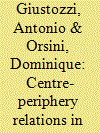

|
|
|
|
|
| Publication |
2009.
|
| Summary/Abstract |
The article offers a review of centre-periphery relations and local politics in the Afghan province of Badakhshan from the 1980s to the post-2001 era. It maps the local powerbrokers and charts the transformations that occurred during this period, with particular reference to the impact of the central government's policies on local political alignments and relations of power. The key argument is that President Karzai's and the cabinet's behaviour towards Badakhshani politics was aimed at re-establishing a patrimonial system, rather than at institution-building as claimed. Unable or unwilling to successfully deal with established local players, Kabul resorted to sponsoring new players in local politics and facilitating their rise in order to weaken more independent powerbrokers. However, a local perception of weakness in Kabul, not least due to uncertainty over the durability of the Karzai administration, led local players, old and new, to behave with very short-term horizons, as 'roving bandits' rather than as 'stationary' ones.
|
|
|
|
|
|
|
|
|
|
|
|
|
|
|
|
| 2 |
ID:
138029
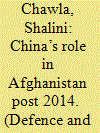

|
|
|
|
|
| Summary/Abstract |
China and Afghanistan are traditional friendly neighbours. China pays great attention to developments in Afghanistan and is committed to deepening both countries' strategic partnership, and so decided to appoint a special envoy.
|
|
|
|
|
|
|
|
|
|
|
|
|
|
|
|
| 3 |
ID:
144774
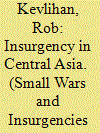

|
|
|
|
|
| Summary/Abstract |
This article considers the experience of civil war in Tajikistan (1992–1997). This civil war represents the most significant violent episode in post-Soviet Central Asia; over a five-year period at least 50,000 people were killed and approximately one tenth of the population were displaced. This article will examine the role of local and international actors during this civil war, with a particular focus on the role that international aid and aid agencies played in governance of vulnerable populations and the impact these interventions had on conflict dynamics and the ability of insurgents to govern in areas under their control.
|
|
|
|
|
|
|
|
|
|
|
|
|
|
|
|
| 4 |
ID:
107539
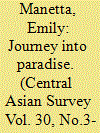

|
|
|
|
|
| Publication |
2011.
|
| Summary/Abstract |
In 2003, a Tajik film crew was permitted to cross the tightly controlled border into Afghan Badakhshan in order to film scenes for a documentary entitled Sacred Traditions in Sacred Places. Although official Tajik state policies and international non-governmental organizations have increasingly stressed freer movement and greater connectivity between the two sides, this 'prescribed community' strongly contrasts with the lived experience of Tajik Badakhshanis. This article explores narratives of nostalgia and dissonance reflected in the film itself and recounted by the film crew in interviews during film production and screening. Engaging with existing work on the interpretation and temporalization of space and post-Soviet nostalgias, I claim that this particular nostalgia emerges in response to new configurations of power and newly imposed pressures valuing cross-border movement. In this case, nostalgia serves as an affective resource helping Tajik Badakhshanis understand and manage daily life and the new potential for border crossing in a highly regulated border zone.
|
|
|
|
|
|
|
|
|
|
|
|
|
|
|
|
| 5 |
ID:
138253


|
|
|
|
|
| Summary/Abstract |
The 1895 Pamir Convention divided the mountainous region of Badakhshan into separate entities under Russian and British/Afghan influence, leading to a remarkable divergence in the development fortunes of a people once united by kinship. For those in today’s GornoBadakhshan in Tajikistan, incorporation into the Soviet Union brought investments in education, health, physical infrastructure, and the economy. People living in Afghanistan’s Badakhshan Province retained more political freedom but lived remotely within a feudal state where development investment was limited. In recent decades, both regions have experienced conflict that has affected their development. In this article, we use findings from quality of life assessments carried out by the Aga Khan Development Network to illustrate the stark differences between the Badakhshans. We discuss ongoing efforts to implement cross-border development programmes to improve quality of life in both Badakhshans, while noting that their success depends on a stable security environment in the region.
|
|
|
|
|
|
|
|
|
|
|
|
|
|
|
|
| 6 |
ID:
127505
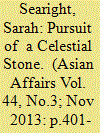

|
|
|
|
|
| Publication |
2013.
|
| Summary/Abstract |
The best Lapis lazuli in the world comes from Afghanistan, from Badakhshan, where it has been mined for over 6,000 years.
Merchants carried lapis to cities all over Mesopotamia and ancient Egypt, where distinctive ornaments have subsequently been excavated. More recently emerged a quite different use of lapis-the grinding of the stone to produce pigment for painting (ultramarine) This technique travelled as much as the stone itself from caves in Asia through wall paintings of the early Middle Ages to the Italian Renaissance and, finally to Titian
|
|
|
|
|
|
|
|
|
|
|
|
|
|
|
|